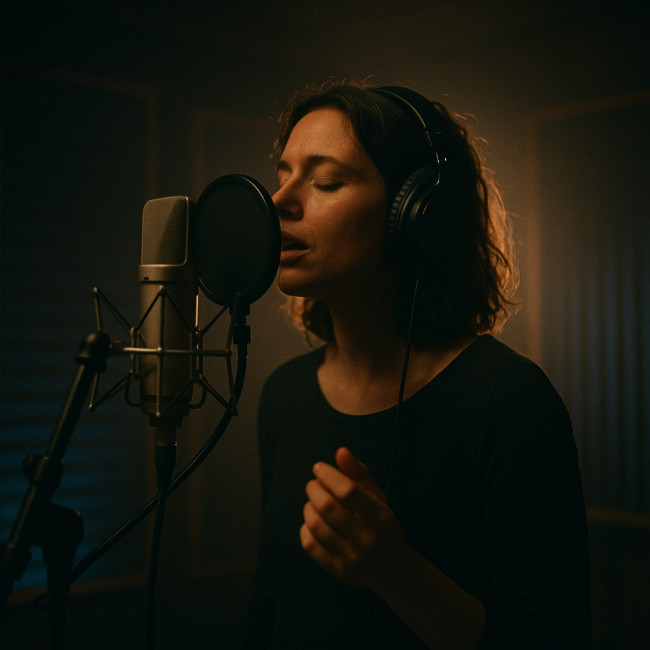Crafting a cinematic vocal reel that convinces directors in under ninety seconds
Directors and music supervisors decide in seconds whether a soundtrack vocalist fits their scene. Learn how to build a cinematic vocal reel that showcases range, emotion and recording quality in less than a minute-and-a-half.
Why a 90-second limit works for cinematic vocal reels

Film decision-makers preview dozens of reels every shift, often while juggling script rewrites, client calls and scoring notes. According to the Vidyard Video Benchmark Report 2023, viewer attention plummets below 50 % after the one-minute mark — and shrinks further with every unnecessary beat. Delivering a razor-focused, 90-second vocal narrative respects their cognitive bandwidth, prevents fatigue and signals that you can tell powerful stories with the same sense of economy. A concise reel:
- Respects busy schedules and increases completion rates.
- Highlights only your strongest moments, avoiding filler.
- Fits easily into emails, talent directories and messaging apps.
Source : Vidyard Video Benchmark Report 2023
The three-act structure of a winning reel
Act 1 – 0-10 s: Establish cinematic tone instantly
Open with your signature vocal colour over an instrumental swell or subtle sound-design hit. A seamless fade-in works better than a hard cut.
Act 2 – 10-70 s: Showcase range and storytelling
- Include two to three contrasting moods (e.g., intimate whisper, soaring belting, hybrid choir layers).
- Keep each clip 15-20 seconds and cross-fade so pacing never stalls.
- Choose keys that flatter your tessitura; sudden leaps appear gimmicky.
Act 3 – 70-90 s: Stick the emotional landing
End with a goosebump-inducing sustained note or cinematic rise, then a clean tail-out. The final three seconds should be silence with your contact slate overlay.
Audio quality standards film directors expect
| Element | Basic Demo | Cinematic Reel |
|---|---|---|
| Sample Rate | 44.1 kHz | 48 kHz (film standard) |
| Peak Level | -1 dBFS | -3 dBFS (gives headroom for score) |
| Noise Floor | -50 dB | < -60 dB |
| File Format | MP3 256 kbps | WAV 24-bit / Broadcast WAV |
For microphone and interface tips, see the detailed audio specs guide for voice demos.
Editing and mixing moves that elevate cinematic impact
Directors listen on studio monitors or headphones. Adopt these production tweaks:
- Dialogue bus compression – gentle 2:1 ratio smooths dynamics.
- Subtle reverb – plate or scoring stage impulse with pre-delay under 30 ms.
- Stereo width automation – widen in climactic phrases, narrow for intimacy.
- Loudness target – aim for LUFS-I around ‑16 for online, ‑20 for DCP uploads.
Dive deeper with advanced mixing tactics recruiters spot in the first 15 seconds.
Visual presentation: minimal yet memorable
- Use a static title card with your name, range and union affiliation.
- Optional waveform animation keeps attention without distracting from the voice.
- Include a short URL or QR leading to your soundtrack vocalist directory profile.
File naming and metadata that surface your reel in searches
Music supervisors often type genre, mood or project code into folder searches. Embed metadata tags:
- Title – “Smith_Soprano_CinematicReel_90s_2024”.
- Comments – include BPM, key and vocal style.
- Cover Art – a 1200×1200 px square with your headshot.
Learn additional tagging hacks in our metadata tactics primer for soundtrack vocals.
Distribution checklist
- Export WAV 48 kHz 24-bit and a lightweight MP3 320 kbps.
- Upload to an unlisted YouTube/Vimeo link with chapters at each mood swap.
- Host the WAV in a shareable Drive or Dropbox folder.
- Add the reel to talent directories; many recruiters use direct playback within listings.
- Attach to cold emails using a 5 MB MP3 or cloud link to avoid spam filters.
Benchmark your pricing before directors ask
After a compelling reel, budget questions follow fast. Align your day rates with the figures in this soundtrack vocal rate benchmark guide so you can reply confidently.
Quick self-assessment quiz
FAQ
- What if my strongest performance exceeds 30 seconds?
- Edit a 15-second highlight; link to the full track separately.
- Should I include spoken introductions?
- No. Let the slate card and metadata speak; directors prefer uninterrupted listening.
- Can I mix live and studio recordings?
- Yes, if the levels and ambience match. Use gentle mastering to unify.
- How often should I update my reel?
- Every six months or after any credit that elevates your portfolio.
Take action now
Block two hours this week to script, edit and master your 90-second cinematic vocal reel. Publish it, then share the link in your next pitch email. Directors notice singers who respect their time – and their timelines.











